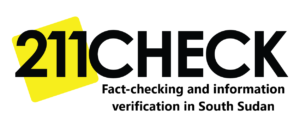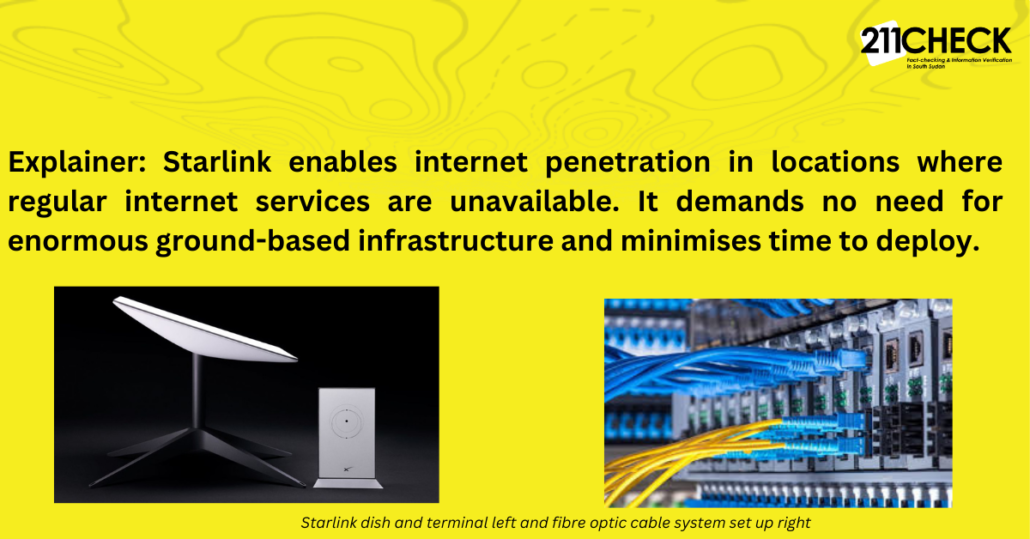Explainer: How Starlink differs from other Internet service providers
Starlink is a satellite internet service offered by Elon Musk’s SpaceX around the world, including South Sudan.
Writer: Makur Majeng
Starlink is a satellite internet service that provides high-speed internet to remote and underserved areas, including everywhere on Earth. Starlink was launched on May 23, 2019, by SpaceX Falcon 9 Rocket. In comparison with traditional telecommunications companies and Internet service providers that offer Internet services, Starlink’s technology operates based on Low Earth Orbit at speeds of 7.7 km/s above the Earth’s surface and conveys Internet coverage directly from space.
Source: Rafael Henrique / LightRocket via Getty Images
The differences between Starlink satellite and traditional Internet service providers (companies).
In contrast to traditional fibre optics, copper cables, cellular networks, or other physical infrastructures, the Starlink network consists of LEO satellites put in orbit. Later, these satellites will be used to establish connections with ground stations and user terminals known as small satellite dishes.
As a result, it allows the company to provide internet services where it is impossible or economically impractical to lay a physical network infrastructure.
Meanwhile, telecom companies typically use fibre-optic cables, Digital Subscriber Lines (DSL), and cellular towers to provide internet services.
On the other hand, Starlink provides global coverage and provides services for citizens in remote and rural areas, but telecom internet companies operate with limited coverage and serve the citizens of the city and suburban areas or wherever there is network infrastructure.
SpaceX’s Starlink Internet Service consists of a ground terminal (right) and antenna for high-speed satellite internet. (Image credit: SpaceX)
What are the pros and cons of Starlink?
Pros
Starlink enables internet penetration in locations where regular internet services are unavailable. It demands no need for enormous ground-based infrastructure and minimises time to deploy.
The satellite infrastructure could ultimately result in lower operating costs compared to traditional physical infrastructures once the entire network is implemented.
Cons
Starlink for starters is expensive, and users must buy a satellite dish and router for setup, and weather-dependent typical performance can suffer from things like snow or rain, and it is also expensive for poor households to acquire Starlink for home use.
The number of countries using Starlink as of August 2024 includes 21 countries from continental America, which are the United States, Puerto Rico, United States Virgin Islands, Guam, Northern Mariana Islands, Canada, Chile, Easter Island, Mexico, Brazil, Dominican Republic, Jamaica, Barbados, Peru, Colombia, Haiti, Ecuador, El Salvador, Panama, Trinidad and Tobago, Guatemala, Bahamas, Honduras, Paraguay, Argentina, Uruguay, and Costa Rica.
In Europe, there are 30 countries, including overseas territories, which include; the United Kingdom, Pitcairn Islands, Germany, France, Saint Martin, Saint Barthélemy, Guadeloupe, Martinique, Austria, Netherlands, Belgium, Ireland, Denmark, Portugal, Switzerland, Poland, Italy, Czechia, Sweden, Croatia, Lithuania, Spain, Slovakia, Slovenia, Bulgaria, Ukraine, Romania, Greece, Latvia, Hungary, North Macedonia, Luxembourg, Moldova, Estonia, Norway, Malta, Finland, Iceland, Cyprus, Georgia, and Albania.
In Oceania, there are 6 countries, which include New Zealand, Australia, Micronesia, Fiji, and Tonga.
On the African continent, there are 13 countries, which include Nigeria, Rwanda, Mozambique, Kenya, Malawi, Zambia, Benin, Eswatini, Sierra Leone, Madagascar, South Sudan, Botswana, and Ghana. In Asia, there are 6 countries: Japan, Philippines, Malaysia, Maldives, Mongolia, and Indonesia.
The Starlink availability map is here.
The global availability of the Starlink maps with the light blue location, source: Starlink
What are the future markets of traditional Internet service providers?
In rural or remote areas of competition, traditional Internet service providers (ISPs) like Liquid, Connect, IPTech, and others, for example, may not be as competitive as Starlink due to high infrastructure costs, and at the same time, the demand for their services may decrease with the growing Starlink penetration due to more users’ acquisitions of Starlink.
For ISPs to compete in reliability, speed, and reachability, they will need to invest heavily in expanding the coverage of fibre optic cable infrastructure in both remote and urban areas, which is financially very costly.
However, Starlink is less costly in terms of infrastructure and can reach areas without cellular tower networks using its terminals and dishes.
In another related development, on January 8th, 2024, SpaceX successfully tested text messaging using its direct-to-cell satellites. The move further aims to overcome the challenge of connecting cell phones and other cellular devices to fast-moving satellites.
Six satellites were launched, which function as cellphone towers in space and will provide text service in 2024 and voice, data services, and the Internet of Things (IoT) in 2025.
This addition, according to Elon Musk, will allow mobile phone connectivity anywhere on Earth. However, he noted that it is not competitive with the existing terrestrial cellular networks.
SpaceX has partnered with T-Mobile and other global operators to utilise the Long Term Evolution (LTE) spectrum, a fourth-generation network wireless standard offering seamless connectivity without the need for new devices or apps.
Conclusion:
Starlink technology is on the verge of becoming a major advancement in terms of the Internet service markets, especially for rural and underprivileged locations. On one hand, it is capable of providing worldwide coverage and scalability.
However, its downsides include weather-dependent reliability and a relatively high cost for starters.
To remain competitive in the evolving telecom landscape, traditional carriers will need to adapt and invest—potentially striking internet infrastructures that cover hard-to-reach areas with reliable affordability for underprivileged locations.
However, the entry of Starlink into the Internet markets has put pressure on traditional Internet service providers on how to retain and maintain market shares.
In South Sudan, the National Communication Authority (NCA) approved Elon Musk’s Starlink Satellite Internet entry on June 26, 2024, and South Sudanese citizens have embraced the internet service compared with the fibre optic one.
To ensure accuracy and transparency, we at 211 Check welcome corrections from our readers. If you spot an error in this article, please request a correction using this form. Our team will review your request and make the necessary corrections immediately, if any.
It’s vital to fight misinformation and disinformation in the media by avoiding fake news. Don’t share content you’re uncertain about. False information can harm and mislead people, risking their lives. Fact-check before sharing. For more details, visit https://211check.org/ or message us on WhatsApp at +211 917 298 255. #FactsMatter

 211 Check website Graphics
211 Check website Graphics